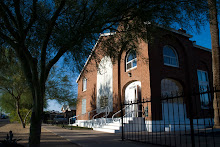I began putting this post together months ago, when the weather was significantly cooler, and I spent much more time walking to visit kids, rather than driving. On a particularly nice day, I happened to walk through an area that I did not often visit on foot. I had never noticed this before:
Pictures of Aim Right? On the sidewalk? With cool history facts? I felt a bit like a tourist as I took pictures and carefully examined everything. (These are actually next to the sidewalk, and the brown/white you see dividing the pictures and text are little pebbles.)
These sidewalks with all the cool history facts and photos about the area are along 11th Street, between Van Buren and Roosevelt.
Even if there weren't sidewalks to share the history of the neighborhood, the majority of the homes there point to another time long ago. My understanding is that homes within the Garfield neighborhood were built between 1883 and 1942, spanning several decades and encompassing various styles of architecture.
Quite a few homes within Garfield have been restored (at least on the exterior) in the last number of years, making it quite an eclectic neighborhood of cared for, restored homes scattered in with dilapidated, neglected ones.
This is one that will catch your eye.

This community of tiny, brightly colored homes known as Spooner Court was established in 1926.
The home with the soft green color has been repainted within the last year, I'd say.
There's a portion of McKinley between 14th and 16th streets that has gradually been filling with renovated homes. This was one of the earliest renovated, if my memory is right.
Simple and modern.
These two are recent renovations near 16th Street and Pierce, where they sit side by side and next to another home undergoing renovation.
Garfield has quite a few historic duplexes.
This home looks like it could be transplanted to the Midwest...siding, white trim, a cozy porch.
The inspiration for the paint color could have come from the foliage in the yard.
I don't know a lot of about the in's and out's of neighborhood transformation, but seeing changes within Garfield makes me wonder: As more properties are renovated and gain that "move-in ready" status that is so popular today, where will the poor live? They reside within Garfield right now because the non-renovated homes are what they can afford, not because it's artsy, historic, and close to downtown. A recent
report revealed that the most expensive apartment rents in the Valley are no longer in Scottsdale, but in downtown Phoenix, along Roosevelt Row, which borders or is part of the Garfield neighborhood.
Over the past year or so, we've already observed our Aim Right demographics changing. Rising numbers of youth who attend our programs actually live outside of the Garfield neighborhood, a few miles to the east or south.
Gentrification does bring obvious positive results to a community. Crime goes down; property values go up. I personally enjoy seeing old homes brought "back to life," and I appreciate order, cleanliness, attention to detail, and pristine appearances.
To be fair, there is still a lot of the neighborhood I didn't photograph. Many of the homes I visit regularly wouldn't win any beautification awards. Toys on the porch and in the yard, random assortments of potted plants and flowers in various stages of dying or blooming, discarded cans and bottles, peeling paint, old windows and doors. They are lived-in homes, and lived in hard since it's not uncommon for two families to share one house. These families are less inclined to visit the artsy cafés and shops downtown and instead frequent the chino (corner store), Circle K, and Ranch Market. While there's a large preparatory academy not too far away, the families have mostly remained loyal to the neighborhood school.
These families walk a lot, to the bus stop if they don't own a vehicle, or to cut down on gas costs if they do own a vehicle. It's rarely because they're concerned about a dog getting exercise. They sit on the porch or keep a window or door of the home cracked. It's cooler that way.
If history repeats itself as gentrification unfolds, more cosmetic changes within Garfield will result in climbing home values, higher rent, professionals and singles moving in who want to be close to jobs or the eclectic shops, and poor families moving out.
A while ago I began a word study on the word poor in the Bible, but I have not yet finished it. It is not a brief topic! This is one verse I encountered that stood out: "Behold, this was the iniquity of your sister Sodom: pride, overabundance of food, prosperous ease, and idleness were hers and her daughters’; neither did she strengthen the hand of the poor and needy." (Ezekiel 16:49 Amplified)
Some Bible translations use help instead of strengthen, but I believe that strengthen conveys a depth of helping that is more than a hand-out or one-time gifts to strangers (though those have their place). How do you strengthen the hand of the poor? I am still fleshing that out, but it probably involves moving out of your realm of comfort (or as Ezekiel calls it, "prosperous ease") to help in some way.
What does that look like with regards to gentrification? Do I respond compassionately to families I know who are affected by rising rent? Can I help provide creative solutions for living on less? Will I encourage them to be good neighbors, to be positive community contributors? Can I mentor kids to stay in school, to do well in school, to graduate, to not get caught up in the gang life or the party life? I believe those might be starting points.




